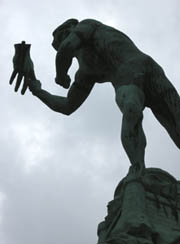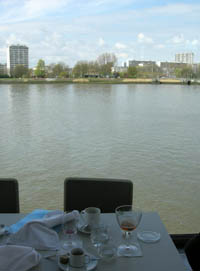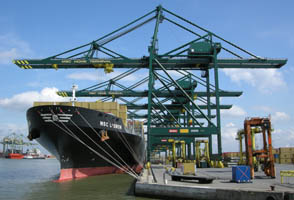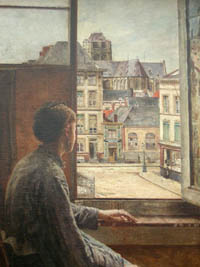Antwerp, A Polished Diamond
Antwerp
by Sarah Shuckburgh
After years of decline, the
sparkle has returned to Belgium’s second city, says Sarah
Shuckburgh.
 Compared with its arch-rival Amsterdam, Antwerp is little
visited. Without an internationally recognised brand-name,
the capital of northern Belgium is in trouble – is it
Anvers, Antwerp or Antwerpen? Originally its name was Aan’t
Werp, an alluvial mound in the river. Or, in Latin, Ante
Verpia. Or was it An’t Werf (on the wharf)? Or perhaps
Hantwerpen – hand-throw - after the legendary hero who tore
off a wicked giant’s hand and threw it into the river. To
add to the confusion, locals are known as Sinjoren. Compared with its arch-rival Amsterdam, Antwerp is little
visited. Without an internationally recognised brand-name,
the capital of northern Belgium is in trouble – is it
Anvers, Antwerp or Antwerpen? Originally its name was Aan’t
Werp, an alluvial mound in the river. Or, in Latin, Ante
Verpia. Or was it An’t Werf (on the wharf)? Or perhaps
Hantwerpen – hand-throw - after the legendary hero who tore
off a wicked giant’s hand and threw it into the river. To
add to the confusion, locals are known as Sinjoren.
My friend Gila is a historian, and on the Eurostar she
imparted some of Antwerp’s turbulent history. I concluded
that the city’s grudge against Amsterdam is justified. By
the 16th century, Antwerp was the wealthiest city in the
western world, a centre of trade, exploration, culture,
painting, printing and finance. But the Golden Age ended
abruptly with the Spanish Fury and the massacre of 6000
citizens. Philip II of Spain closed the river Scheldt, the
protestant elite left, and Antwerp suffered successive wars,
uprisings, rages and periods of foreign rule. The river was
finally unblocked only in 1863.
 Visitors to Belgium tend to prefer picturesque Bruges to
Antwerp, where medieval canals were paved over during the
19th century. And Sinjoren are also touchy about Brussels.
Although Antwerp was historically a far greater city,
Brussels was chosen as the capital when Belgium was created
in 1830. The tiny country is thoroughly fissured: there’s
tension between Antwerp’s Dutch-speaking Flemish and the
French-speaking Walloons, between town and province, between
north and south, between Protestant and Catholic, and
linguistic extremists such as Vlaams Belang and le Front des
Francophones advocate segregation and separation. Visitors to Belgium tend to prefer picturesque Bruges to
Antwerp, where medieval canals were paved over during the
19th century. And Sinjoren are also touchy about Brussels.
Although Antwerp was historically a far greater city,
Brussels was chosen as the capital when Belgium was created
in 1830. The tiny country is thoroughly fissured: there’s
tension between Antwerp’s Dutch-speaking Flemish and the
French-speaking Walloons, between town and province, between
north and south, between Protestant and Catholic, and
linguistic extremists such as Vlaams Belang and le Front des
Francophones advocate segregation and separation.
 But meanwhile, Antwerp’s economic fortunes have revived.
Recently dubbed Cultural Capital of Europe, Belgium’s second
city makes an excellent weekend destination. Gila and I took
the Eurostar from St Pancras to Brussels, and 30 minutes
later we stepped out of Antwerp’s imposing Centraal station
into the diamond district. But meanwhile, Antwerp’s economic fortunes have revived.
Recently dubbed Cultural Capital of Europe, Belgium’s second
city makes an excellent weekend destination. Gila and I took
the Eurostar from St Pancras to Brussels, and 30 minutes
later we stepped out of Antwerp’s imposing Centraal station
into the diamond district.
Antwerp’s diamond trade, which began in the 15th century,
was eclipsed when Amsterdam took over as Europe’s major
diamond market in the 17th century. But today Antwerp is
back on top, trading half the world’s cut diamonds (compared
to Amsterdam’s one per cent) and 85% of its rough diamonds.
The city boasts 1500 diamond companies, and four of the
world’s 21 diamond bourses. The largest and most valuable
diamonds are cut and polished here, the ‘Antwerp cut’ a
guarantee of purity and beauty.
Small and portable, diamonds were first brought to Antwerp
by Jews fleeing persecution, and Jewish traders controlled
the diamond market for centuries. Today, the streets throng
with Indian traders, but they still seal transactions with a
traditional handshake and the Yiddish phrase “Mazzel und
Broche”. Diamond deals have no written receipts.
 Our first stop was the World Diamond Centre for some geology
(diamonds are compressed underground for millions of years)
and some history (diamonds were first discovered in India,
and first used for decoration by Moghuls). Rough stones
mined in Africa, Canada, Russia, Australia and South America
arrive in Antwerp to be cut, polished and traded. A
reconstruction of a 19th-century family workshop showed how
the husband would set a diamond in molten lead and
laboriously grind each facet with diamond dust, on a
turntable revolved by his children, while his wife swept
diamond dust from the floor. Diamonds are the hardest
mineral in the world, and nothing but diamonds will cut
them. Our first stop was the World Diamond Centre for some geology
(diamonds are compressed underground for millions of years)
and some history (diamonds were first discovered in India,
and first used for decoration by Moghuls). Rough stones
mined in Africa, Canada, Russia, Australia and South America
arrive in Antwerp to be cut, polished and traded. A
reconstruction of a 19th-century family workshop showed how
the husband would set a diamond in molten lead and
laboriously grind each facet with diamond dust, on a
turntable revolved by his children, while his wife swept
diamond dust from the floor. Diamonds are the hardest
mineral in the world, and nothing but diamonds will cut
them.
Antwerp is the perfect place to buy diamonds, and Gila and I
suddenly thought of convincing reasons to purchase. My
parents’ diamond wedding – what about a sparkly brooch to
celebrate 60 years together? Or we could suggest engagement
rings to our career-mad offspring, all intent on postponing
marriage and babies. Or – daring thought – we could buy
jewellery for ourselves.
 In Van der Veken’s atelier, bespoke jewellery is made by
hand, using top-quality African diamonds, cut and polished
in Antwerp. We watched silent craftsmen, perched at
chin-high benches, each peering intently through an
eye-piece. Mr Van der Veken was scathing about his customers
- spoilt heiresses and tycoons used to getting their own way
- like the man who demanded 21 identical diamond necklaces,
one for each of his daughters and granddaughters (Mr V took
months to find exactly matching, graded stones), or the lady
who telephoned Mr V at home one Saturday night, to get him
to come and fasten her earrings. In Van der Veken’s atelier, bespoke jewellery is made by
hand, using top-quality African diamonds, cut and polished
in Antwerp. We watched silent craftsmen, perched at
chin-high benches, each peering intently through an
eye-piece. Mr Van der Veken was scathing about his customers
- spoilt heiresses and tycoons used to getting their own way
- like the man who demanded 21 identical diamond necklaces,
one for each of his daughters and granddaughters (Mr V took
months to find exactly matching, graded stones), or the lady
who telephoned Mr V at home one Saturday night, to get him
to come and fasten her earrings.
His disloyal tales did not detract from the lure of his
diamonds. Squinting at pieces through a ‘loupe’, we
marvelled at the twinkling facets and the craftsmen’s tiny
golden pins. Mr V plied us with information: we must
remember the four Cs – cut, colour, clarity and carat. Carat
is a unit of weight – a corruption of ‘carob’, a bean with
seeds of remarkably uniform size. Coloured diamonds are rare
and coveted. “When it comes to the cut”, confided Mr V, “I
recommend the ‘brilliant’, to maximise sparkle. And the way
to clean diamonds is in boiling water”.
Gila and I took off our plastic earrings and replaced them
with glittering cascades. Around our necks, Mr V arranged
garlands of brilliants which flooded our faces with light.
We looked like princesses.
 Diamonds intrigued and diverted us, but Antwerp has many
other delights. Even more important to Antwerp’s economy is
its port - the second largest in Europe and fifth largest in
the world. There are plans to double the size of the docks,
which already handle 8 million containers a year. Gila and I
spent a fascinating afternoon on a boat, touring this
maritime metropolis of gantries, silos and wharves,
silhouetted between grey water and huge empty skies - a
world apart from the delicate towers and spires of the city
just behind us. The docks are 50 miles from the sea, and
ships have to navigate the winding river Scheldt between
sandbanks and through locks. Cargo from 800 destinations
worldwide is processed, refined, repacked and shipped out
again, or moved on throughout Europe by pipeline, rail,
lorry or barge. We watched tugs manoeuvring a Chilean ship
carrying fertiliser ingredients, while nearby giant cranes
delicately scooped up house-sized containers of bananas. We
chugged past towers of granite, dark mountains of coal, and
warehouses full of coffee, tropical fruit and spices. Diamonds intrigued and diverted us, but Antwerp has many
other delights. Even more important to Antwerp’s economy is
its port - the second largest in Europe and fifth largest in
the world. There are plans to double the size of the docks,
which already handle 8 million containers a year. Gila and I
spent a fascinating afternoon on a boat, touring this
maritime metropolis of gantries, silos and wharves,
silhouetted between grey water and huge empty skies - a
world apart from the delicate towers and spires of the city
just behind us. The docks are 50 miles from the sea, and
ships have to navigate the winding river Scheldt between
sandbanks and through locks. Cargo from 800 destinations
worldwide is processed, refined, repacked and shipped out
again, or moved on throughout Europe by pipeline, rail,
lorry or barge. We watched tugs manoeuvring a Chilean ship
carrying fertiliser ingredients, while nearby giant cranes
delicately scooped up house-sized containers of bananas. We
chugged past towers of granite, dark mountains of coal, and
warehouses full of coffee, tropical fruit and spices.
Perhaps because of the port’s exotic foodstuffs, Antwerp has
a reputation for gourmet cuisine. Sure enough, we ate
fantastically well – and still found room for the locals’
favourite snack of chips, mayonnaise and Belgian beer.
 Next, we looked up the Antwerp Six - not (as I supposed)
terrorists, but designers who took London by storm 30 years
ago, establishing Antwerp as a leading fashion centre. Gila
and I were daunted by the couture, but enchanted by the
architecture. Dries van Noten’s shop is elegant belle
époque, with marble floors and chandeliers. Dirk van Saene
and Walter van Beirendonck, director of Antwerp’s Fashion
School, have turned a steel-and-glass-roofed garage into
their showroom. Ann Demeulemeester’s shop is a cavernous
two-storey space with dark rafters and a leafy conservatory. Next, we looked up the Antwerp Six - not (as I supposed)
terrorists, but designers who took London by storm 30 years
ago, establishing Antwerp as a leading fashion centre. Gila
and I were daunted by the couture, but enchanted by the
architecture. Dries van Noten’s shop is elegant belle
époque, with marble floors and chandeliers. Dirk van Saene
and Walter van Beirendonck, director of Antwerp’s Fashion
School, have turned a steel-and-glass-roofed garage into
their showroom. Ann Demeulemeester’s shop is a cavernous
two-storey space with dark rafters and a leafy conservatory.
Just opposite her shop in the arty Zuid district is the Fine
Art museum, a late 19th-century edifice with a monumental
staircase but intimate galleries, sparsely hung. Flemish
treasures include a tiny Madonna by van Eyck, Cranach’s
marvellous Eve, sculptures by the Quellins, and exquisite
paintings by Teniers the Younger, Brouwer, Jordaens, the
Bruegels, Frans Hals and Van Dyck - and by Antwerp’s master
of the high renaissance, Rubens.
 Despite Antwerp’s economic collapse in the 17th century, the
Counter-Reformation allowed baroque art to flourish, as
Catholic churches were rebuilt and extended. Rubens
contributed to the façade decorations of the Jesuit Carolus
Borromeus church, and provided four paintings for Antwerp
cathedral, including the superb Raising of the Cross. While
Antwerp slumped, Rubens became spectacularly wealthy. His
castle has not survived, but his townhouse is an impressive
testament - a Dutch burgher mansion with the painter’s
grandiose additions, including a studio with a viewing
gallery for admirers, a large garden, and a marble rotunda
for his collection of classical sculptures. Despite Antwerp’s economic collapse in the 17th century, the
Counter-Reformation allowed baroque art to flourish, as
Catholic churches were rebuilt and extended. Rubens
contributed to the façade decorations of the Jesuit Carolus
Borromeus church, and provided four paintings for Antwerp
cathedral, including the superb Raising of the Cross. While
Antwerp slumped, Rubens became spectacularly wealthy. His
castle has not survived, but his townhouse is an impressive
testament - a Dutch burgher mansion with the painter’s
grandiose additions, including a studio with a viewing
gallery for admirers, a large garden, and a marble rotunda
for his collection of classical sculptures.
Printers also benefited from the Counter-Reformation, as
liturgical tracts were commissioned for Europe and South
America. Antwerp’s most unusual and memorable museum is a
creaky-floored house where the Plantijn-Moretus family ran
their printing company from 1576 until 1876. In 300 years
they never threw anything away, and the museum - a World
Heritage Site - has a unique collection of presses, type
stores, foundries, correctors’ desks and an archive of
thousands of books and papers, including a Gutenberg bible
and several maps by Mercator.
Over a cup of frothy hot chocolate at Günther Watté’s
delectable cafe, Gila and I discussed the highlights of our
weekend – printing, paintings, food, fashion, churches,
chocolate, docks and diamonds. Amsterdam? Bruges? Brussels?
Antwerp wins hands down.
First published by the Telegraph
©SarahShuckburgh |